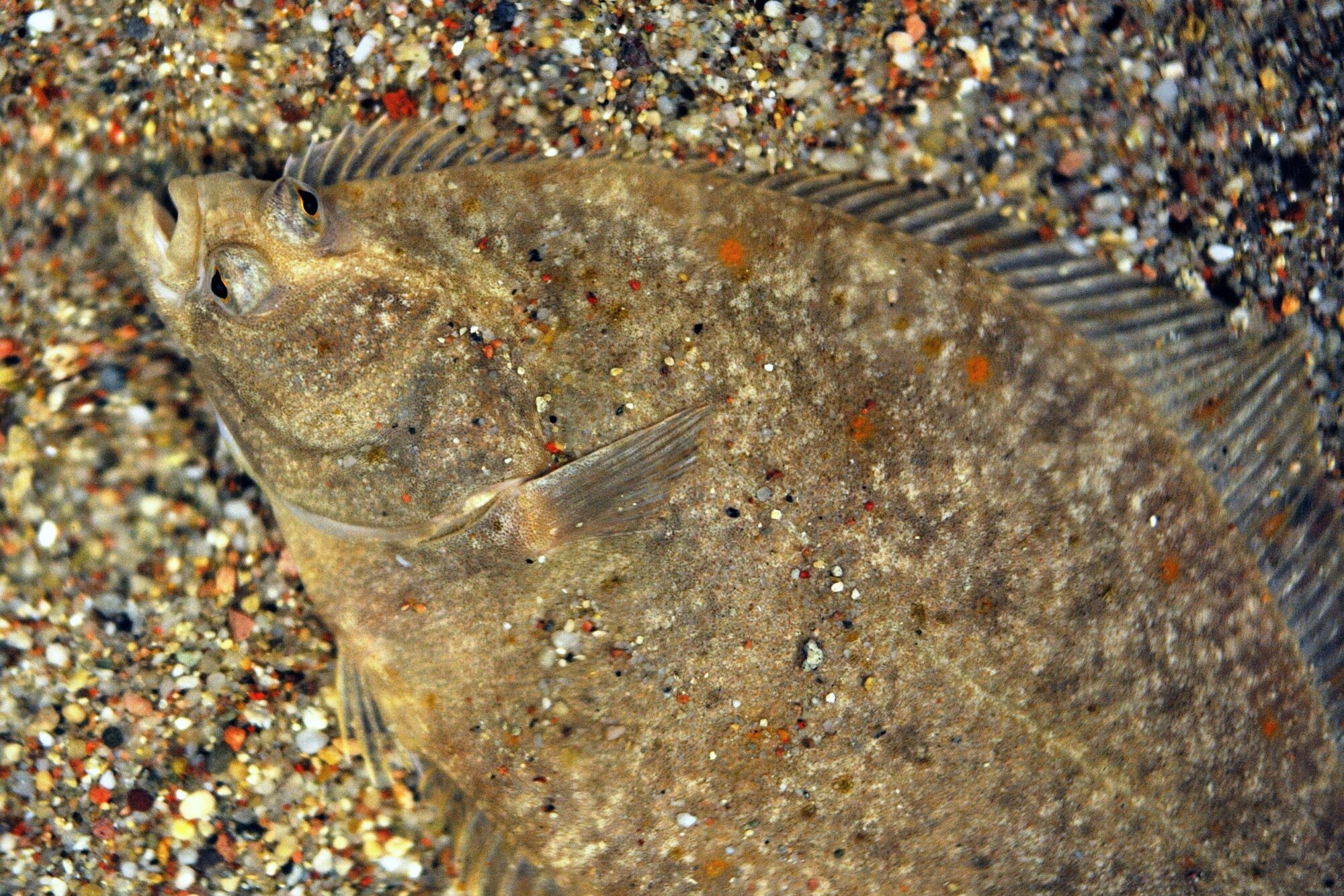Platichthys flesus
Order: Pleuronectiformes | Rodzina: Pleuronectidae


This flat fish inhabits European coastal waters, ranging from the Barents Sea and the White Sea, through the Norwegian Sea, the North Sea, the Baltic Sea, and the Bay of Biscay, to the Mediterranean Sea. It was introduced to the United States and Canada by pure chance, probably through transport in ballast water. Although it is a sea species, it can also be found in salt waters and up rivers, where it lives near the bottom at depths of up to 100 m. It is a nocturnal species that buries itself in sand during the day to wait for prey or hide from predators.
Appearance
Adults of the species typically grow up to 50 cm in length, although they can reach up to 60 cm and weigh up to 14 kg. The European flounder found in the Baltic Sea is much smaller, reaching around 35 cm in length and living from 8 to 9 years. The flounder has an asymmetrical and heavily flattened oval-shaped body, with a height that is half of its length. As this fish swims and lays on its side, we cannot discern a dorsal and pelvic side when we talk about its coloration. Therefore, we have to describe the visible top and bottom parts. The top is dyed with colors ranging from olive to deep brown with red and brown spots, depending on the habitat. The bottom side is always white. This fish can change its coloration to blend in. For example, flounders at sea bottoms with rocks will be darker than those at sea bottoms made entirely out of sand. Its body is covered in scales, some of which are rough bone plates, especially sharp along the lateral line and at the base of its odd fins. This distinguishes the European flounder from other plaice. Its small mouth limits its diet to small organisms.
Sustenance
The European flounder looks for food near the sea bottom above which it swims, comprising of polychaetes, mollusks, snails, crustaceans, and small fish. The juveniles, which are planktonic, eat plankton and the larvae of insects. It is a gonochoristic animal, reaching sexual maturity at the age of three. Individuals that spend their summer in fresh waters start their journey to the open sea in the fall to spawn. Spawning takes place in very salty waters, at temperatures between 3 and 7°C, and at a depth of 30 to 300 meters. In the southern part of the Baltic Sea, the spawning occurs from March to May and takes place in the Słupsk Furrow and the depths of the Gdańsk and Bornholm Basins, and coś Arkońskiego. The female lays from 100,000 to 2 million grains of roe, which float on the surface. Hatching is dependent on the temperature and takes place during the 5th and 11th day of the laying. The larvae’s length after hatching is around 3 mm, and its body is symmetrical. The transformation begins when it reaches 7 mm. The juveniles migrate to the shallows and up rivers. The flounder is an important species in the fishing industry and is valued for its meat. It can also be found in aquariums. The P. flesus species has six discernible subspecies, depending on the habitat. These are the nominative subspecies (upon which the European flounder was first described), White Sea, Northern, Baltic, Mediterranean, and Black Sea flounder.
Flounder – a fish with eyes on one side
The larva of this fish is symmetrical after hatching. Its body begins to transform when it reaches a length of 7 mm, and the eye starts its journey. By the time a juvenile reaches a length of 1 cm, one of its eyes is already in the middle of its head. The eye moves simultaneously with the fish’s growth and eventually nears the second eye. The symmetry of the fish’s body changes at the same time as the eye’s journey. Initially, the larva moves like any other fish, with its back up. However, over time, the symmetry shifts either to the right or left, and ultimately, the juvenile swims and lies on its side. In 70% of the cases, the left side becomes the bottom side, which means that both eyes are on the right side. Although plaices are distinguishable from other fish today, they probably evolved from forms similar in shape to modern Percidae fish. Their ancestors had symmetrical bodies, which is evident from the presence of symmetrical larvae that undergo an extraordinary transformation.


